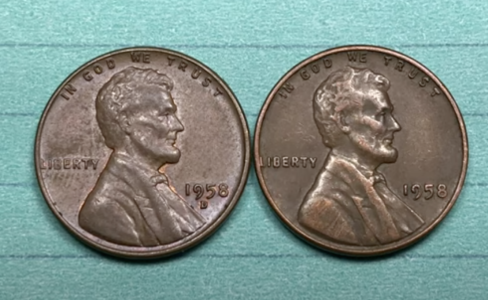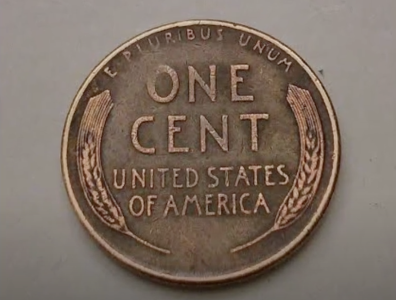Do you have these rare pennies? Find out if your spare change could be worth hundreds!
- Replies 0
If you’re like many others at The GrayVine, you probably have a coffee can, a mason jar, or maybe even an old sock drawer brimming with pennies and nickels.
They rattle around, gathering dust, and you might wonder: Is there hidden treasure in that pile of copper and zinc? Could one of those humble wheat pennies be your ticket to a small fortune—or at least a nice dinner out?
Let’s dig into the truth about wheat pennies, the legends, the facts, and how to tell if you’re sitting on a gold mine or just a handful of pocket change.
The Penny’s Place in American Life (and Why We Still Care)
Pennies have been a part of American pockets since the days of Abraham Lincoln, but in recent years, they’ve become more of a nuisance than a necessity.
According to the Federal Reserve, the average American household has $60 to $90 in loose change lying around—enough to fill a couple of pint glasses. Yet, millions of dollars in coins are tossed out every year, literally thrown away as if they’re worthless.
But before you dump your change jar, let’s talk about the wheat penny—a coin that’s sparked more than a few dreams of striking it rich.

What Exactly Is a Wheat Penny?
Wheat pennies, officially known as Lincoln Wheat Cents, were minted from 1909 to 1958.
Flip one over, and you’ll see two stalks of wheat arching around the words “One Cent.” After 1958, the design changed to the Lincoln Memorial, and the wheat stalks were retired.
These coins are a favorite among collectors, partly because of their classic design and partly because of the stories that swirl around their value.
Are Wheat Pennies Really Worth Anything?
Let’s cut through the hype. You may have seen headlines screaming, “Lincoln Wheat Penny Worth $124 Million—You Could Have One!”
Also read: This penny in your drawer could be worth more than you think!
The reality? Most wheat pennies are worth just a bit more than face value—maybe two or three cents if they’re in decent shape.
Donn Pearlman, spokesman for the Professional Numismatists Guild, puts it plainly: “There are million-dollar pennies, but there are no $100 million pennies.”
Only a handful of Lincoln cents, mostly from 1909 to 1958, have ever sold for $1 million or more—and those are the rarest of the rare.
The Holy Grail: The 1943 Copper Wheat Penny
If you’re hoping to find a penny that could pay off your mortgage, you’re looking for the legendary 1943 copper wheat penny.

During World War II, the US Mint switched from copper to zinc-coated steel to save copper for the war effort.
But a few copper blanks slipped through the cracks, and those 1943 copper pennies are now the stuff of numismatic legend.
How rare are they? Only a handful are known to exist. One sold for over $200,000 at auction in 2019, and in the rarest cases, they’ve fetched up to $1 million.
But the odds of finding one in your change are about the same as winning the lottery.
Also read: Discover the one penny date that could turn your loose change into a $240,000 windfall—learn the secret behind its rare material!
Other Valuable Wheat Pennies to Watch For
While most wheat pennies are worth a few cents, some can fetch a tidy sum—especially if they’re in pristine condition or have minting errors. Here are a few to keep an eye out for:
Source: Treasure Town / Youtube.
Beware of the Hype (and the Scams)
With all the buzz about valuable pennies, coin shops have been flooded with hopeful folks convinced they’ve found a fortune.
Unfortunately, most of the time, the coins are common dates or in poor condition.
Related story: 9 coins that could be worth a fortune – check your pockets and purses immediately!
Worse, the internet is awash with overpriced coins and even counterfeits—especially on sites like eBay and Etsy. Some fakes are so convincing that even experienced collectors can be fooled.
If you think you’ve found something special, don’t rush to sell it online. Take a breath, do your homework, and get a professional opinion.
Read next: Are pennies on the way out? What the end of the one-cent coin could mean for you

Have you ever found a rare coin in your change? Do you have a family story about a valuable penny or a favorite coin-collecting memory? Or maybe you have questions about how to start your own collection? Share your stories, questions, and tips in the comments below!
They rattle around, gathering dust, and you might wonder: Is there hidden treasure in that pile of copper and zinc? Could one of those humble wheat pennies be your ticket to a small fortune—or at least a nice dinner out?
Let’s dig into the truth about wheat pennies, the legends, the facts, and how to tell if you’re sitting on a gold mine or just a handful of pocket change.
The Penny’s Place in American Life (and Why We Still Care)
Pennies have been a part of American pockets since the days of Abraham Lincoln, but in recent years, they’ve become more of a nuisance than a necessity.
According to the Federal Reserve, the average American household has $60 to $90 in loose change lying around—enough to fill a couple of pint glasses. Yet, millions of dollars in coins are tossed out every year, literally thrown away as if they’re worthless.
But before you dump your change jar, let’s talk about the wheat penny—a coin that’s sparked more than a few dreams of striking it rich.

Most wheat pennies (minted between 1909 and 1958) are only worth a few cents above face value, despite hype from online headlines suggesting otherwise. Image source: DC Coin World / Youtube.
What Exactly Is a Wheat Penny?
Wheat pennies, officially known as Lincoln Wheat Cents, were minted from 1909 to 1958.
Flip one over, and you’ll see two stalks of wheat arching around the words “One Cent.” After 1958, the design changed to the Lincoln Memorial, and the wheat stalks were retired.
These coins are a favorite among collectors, partly because of their classic design and partly because of the stories that swirl around their value.
Are Wheat Pennies Really Worth Anything?
Let’s cut through the hype. You may have seen headlines screaming, “Lincoln Wheat Penny Worth $124 Million—You Could Have One!”
Also read: This penny in your drawer could be worth more than you think!
The reality? Most wheat pennies are worth just a bit more than face value—maybe two or three cents if they’re in decent shape.
Donn Pearlman, spokesman for the Professional Numismatists Guild, puts it plainly: “There are million-dollar pennies, but there are no $100 million pennies.”
Only a handful of Lincoln cents, mostly from 1909 to 1958, have ever sold for $1 million or more—and those are the rarest of the rare.
The Holy Grail: The 1943 Copper Wheat Penny
If you’re hoping to find a penny that could pay off your mortgage, you’re looking for the legendary 1943 copper wheat penny.

Very rare examples, such as 1943 copper Lincoln wheat pennies, can be worth thousands or even up to a million dollars, but finding one is extremely unlikely. Image source: Coins Master / Youtube.
During World War II, the US Mint switched from copper to zinc-coated steel to save copper for the war effort.
But a few copper blanks slipped through the cracks, and those 1943 copper pennies are now the stuff of numismatic legend.
How rare are they? Only a handful are known to exist. One sold for over $200,000 at auction in 2019, and in the rarest cases, they’ve fetched up to $1 million.
But the odds of finding one in your change are about the same as winning the lottery.
Also read: Discover the one penny date that could turn your loose change into a $240,000 windfall—learn the secret behind its rare material!
Other Valuable Wheat Pennies to Watch For
While most wheat pennies are worth a few cents, some can fetch a tidy sum—especially if they’re in pristine condition or have minting errors. Here are a few to keep an eye out for:
- 1909-S VDB: The first year of the Lincoln cent, with the designer’s initials (V.D.B.) on the reverse and minted in San Francisco. These can be worth hundreds or even thousands, depending on condition.
- 1914-D: A low-mintage year from the Denver Mint, often worth $200 or more in good condition.
- 1922 “No D”: A rare error where the Denver mintmark is missing. These can be worth several hundred dollars.
- 1955 Double Die: A famous error where the date and lettering appear doubled. These can fetch $1,000 or more.
Source: Treasure Town / Youtube.
Beware of the Hype (and the Scams)
With all the buzz about valuable pennies, coin shops have been flooded with hopeful folks convinced they’ve found a fortune.
Unfortunately, most of the time, the coins are common dates or in poor condition.
Related story: 9 coins that could be worth a fortune – check your pockets and purses immediately!
Worse, the internet is awash with overpriced coins and even counterfeits—especially on sites like eBay and Etsy. Some fakes are so convincing that even experienced collectors can be fooled.
If you think you’ve found something special, don’t rush to sell it online. Take a breath, do your homework, and get a professional opinion.
Read next: Are pennies on the way out? What the end of the one-cent coin could mean for you
Key Takeaways
- Most wheat pennies (minted between 1909 and 1958) are only worth a few cents above face value, despite hype from online headlines suggesting otherwise.
- Very rare examples, such as 1943 copper Lincoln wheat pennies, can be worth thousands or even up to a million dollars, but finding one is extremely unlikely.
- Increased interest and misleading information have led coin shops to be inundated with people wrongly believing they possess highly valuable coins, and there’s also been a rise in counterfeit wheat pennies.
- If you think your coins might be valuable, it’s best to consult reputable price guides or have them graded and authenticated by professional services, rather than relying on online claims or appraisals.
Have you ever found a rare coin in your change? Do you have a family story about a valuable penny or a favorite coin-collecting memory? Or maybe you have questions about how to start your own collection? Share your stories, questions, and tips in the comments below!





